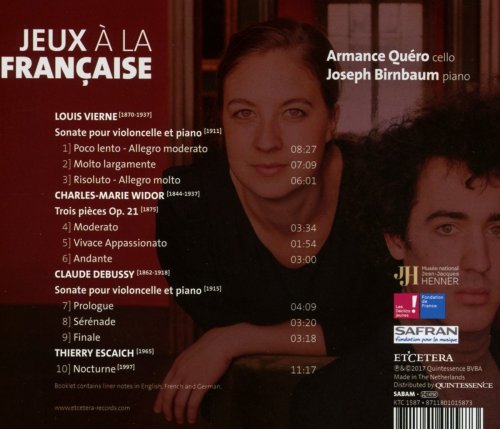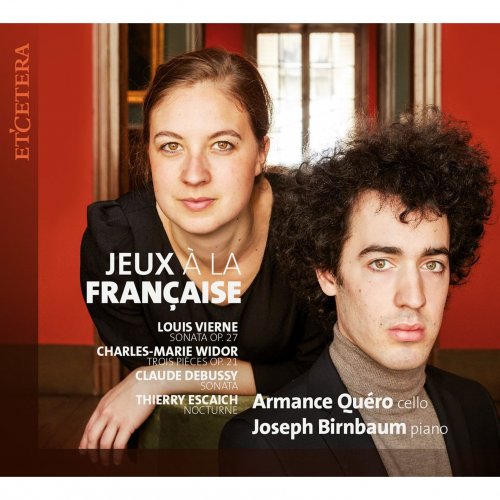
Armance Quéro, Joseph Birnbaum - Vierne & Widor & Debussy & Escaich: Jeux à la française (2017)
BAND/ARTIST: Armance Quéro, Joseph Birnbaum
- Title: Vierne & Widor & Debussy & Escaich: Jeux à la française
- Year Of Release: 2017
- Label: Etcetera
- Genre: Classical
- Quality: flac lossless (tracks)
- Total Time: 00:51:28
- Total Size: 216 mb
- WebSite: Album Preview
Tracklist
01. Sonate pour violoncelle et piano, Op. 27: I. Poco lento – Allegro moderato
02. Sonate pour violoncelle et piano, Op. 27: II. Molto largamente
03. Sonate pour violoncelle et piano, Op. 27: III. Risoluto – Allegro molto
04. Trois pièces, Op. 21: I. Moderato
05. Trois pièces, Op. 21: II. Vivace appassionato
06. Trois pièces, Op. 21: III. Andante
07. Sonate pour violoncelle et piano, L.135: I. Prologue: Lent, sostenuto e molto risoluto
08. Sonate pour violoncelle et piano, L.135: II. Sérénade: Modérément animé
09. Sonate pour violoncelle et piano, L.135: III. Finale: Animé, léger et nerveux
10. Nocturne

The scarcity of the repertoire and the performers’ desire to have new pieces to play are the arguments put forth by the composer during his negotiations with his publisher about his latest work. However, the historical facts are somewhat less clear-cut. From the second half of the nineteenth century, the French repertoire for cello and piano already contained many sonatas – by Charles-Valentin Alkan (1857), Louise Farrenc (1857), Henri Duparc (1867), Camille Saint-Saëns (1872 and 1905), Charles-Marie Widor (1880), Maurice Emmanuel (1890), Albéric Magnard (1911) and Louis Vierne (1911). On the other hand, Debussy’s was obviously the catalyst for many works after its publication, such as the sonatas by Gabriel Fauré (op. 117 in 1917, op. 121 in 1921), Charles Kœchlin (1917), Arthur Honegger (1920), Gabriel Pierné (1921) and Vincent d’Indy (1924). The reasons for this sudden proliferation are manifold. The sociological background was a significant factor, with the creation of the Société Nationale in 1871 and the Société Musicale Indépendante in 1909. To which must be added the weight of the chamber music societies and social circles, such as the musical salons of amateurs, music-lovers and professional musicians, including Saint-Saëns’ “Mondays” or Duparc’s “Tuesdays”. Finally, the excellence of the French cello school also played a major role.
01. Sonate pour violoncelle et piano, Op. 27: I. Poco lento – Allegro moderato
02. Sonate pour violoncelle et piano, Op. 27: II. Molto largamente
03. Sonate pour violoncelle et piano, Op. 27: III. Risoluto – Allegro molto
04. Trois pièces, Op. 21: I. Moderato
05. Trois pièces, Op. 21: II. Vivace appassionato
06. Trois pièces, Op. 21: III. Andante
07. Sonate pour violoncelle et piano, L.135: I. Prologue: Lent, sostenuto e molto risoluto
08. Sonate pour violoncelle et piano, L.135: II. Sérénade: Modérément animé
09. Sonate pour violoncelle et piano, L.135: III. Finale: Animé, léger et nerveux
10. Nocturne

The scarcity of the repertoire and the performers’ desire to have new pieces to play are the arguments put forth by the composer during his negotiations with his publisher about his latest work. However, the historical facts are somewhat less clear-cut. From the second half of the nineteenth century, the French repertoire for cello and piano already contained many sonatas – by Charles-Valentin Alkan (1857), Louise Farrenc (1857), Henri Duparc (1867), Camille Saint-Saëns (1872 and 1905), Charles-Marie Widor (1880), Maurice Emmanuel (1890), Albéric Magnard (1911) and Louis Vierne (1911). On the other hand, Debussy’s was obviously the catalyst for many works after its publication, such as the sonatas by Gabriel Fauré (op. 117 in 1917, op. 121 in 1921), Charles Kœchlin (1917), Arthur Honegger (1920), Gabriel Pierné (1921) and Vincent d’Indy (1924). The reasons for this sudden proliferation are manifold. The sociological background was a significant factor, with the creation of the Société Nationale in 1871 and the Société Musicale Indépendante in 1909. To which must be added the weight of the chamber music societies and social circles, such as the musical salons of amateurs, music-lovers and professional musicians, including Saint-Saëns’ “Mondays” or Duparc’s “Tuesdays”. Finally, the excellence of the French cello school also played a major role.
Year 2017 | Classical | FLAC / APE
As a ISRA.CLOUD's PREMIUM member you will have the following benefits:
- Unlimited high speed downloads
- Download directly without waiting time
- Unlimited parallel downloads
- Support for download accelerators
- No advertising
- Resume broken downloads


